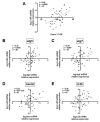Calcium-Sensing Receptor in Adipose Tissue: Possible Association with Obesity-Related Elevated Autophagy
- PMID: 33076271
- PMCID: PMC7590196
- DOI: 10.3390/ijms21207617
Calcium-Sensing Receptor in Adipose Tissue: Possible Association with Obesity-Related Elevated Autophagy
Abstract
Autophagy is upregulated in adipose tissue (AT) from people with obesity. We showed that activation of the calcium-sensing receptor (CaSR) elevates proinflammatory cytokines through autophagy in preadipocytes. Our aim is to understand the role of CaSR on autophagy in AT from humans with obesity. We determined mRNA and protein levels of CaSR and markers of autophagy by qPCR and western blot in human visceral AT explants or isolated primary preadipocytes (60 donors: 72% female, 23-56% body fat). We also investigated their association with donors' anthropometric variables. Donors' % body fat and CaSR mRNA expression in AT were correlated (r = 0.44, p < 0.01). CaSR expression was associated with mRNA levels of the autophagy markers atg5 (r = 0.37, p < 0.01), atg7 (r = 0.29, p < 0.05) and lc3b (r = 0.40, p < 0.01). CaSR activation increased becn and atg7 mRNA expression in AT. CaSR activation also upregulated LC3II by ~50%, an effect abolished by the CaSR inhibitor. Spermine (CaSR agonist) regulates LC3II through the ERK1/2 pathway. Structural equation model analysis suggests a link between donors' AT CaSR expression, AT autophagy and expression of Tumor Necrosis Factor alpha TNF-α. CaSR expression in visceral AT is directly associated with % body fat, and CaSR activation may contribute to obesity-related disruption in AT autophagy.
Keywords: autophagy; calcium-sensing receptor; obesity; visceral adipose tissue.
Conflict of interest statement
The authors declare that they have no conflict of interest.
Figures






References
-
- Mattar P., Bravo-Sagua R., Tobar N., Fuentes C., Tronsoco R., Breitwieser G., Lavandero S., Cifuentes M. Autophagy mediates calcium-sensing receptor-induced TNFalpha production in human preadipocytes. Biochim. Biophys. Acta Mol. Basis Dis. 2018;1864:3585–3594. doi: 10.1016/j.bbadis.2018.08.020. - DOI - PubMed
MeSH terms
Substances
Grants and funding
- 1150651/Fondo Nacional de Desarrollo Científico y Tecnológico
- 1152075/Fondo Nacional de Desarrollo Científico y Tecnológico
- 15130011/Financiamiento de Centros de Investigación en Áreas Prioritarias
- 21130162/Fondo Nacional de Desarrollo Científico y Tecnológico
- 3190416/Fondo Nacional de Desarrollo Científico y Tecnológico
LinkOut - more resources
Full Text Sources
Medical
Miscellaneous

